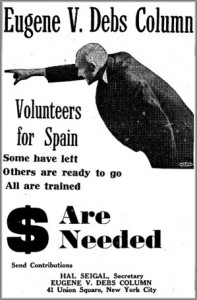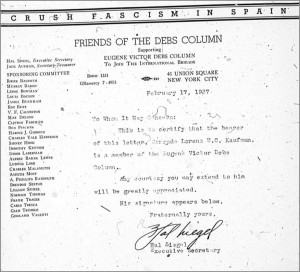Lorenz Kaufman and the Eugene Victor Debs Column
The January 2, 1937 issue of the Socialist Call announced the formation of a 500-man volunteer military formation: The Eugene V. Debs Column (hereafter Debs). The Debs would serve with the Republican armed forces in Spain. The American Socialist party initiated an aggressive campaign to recruit volunteers with military or relevant technical experience. Subsequently, the party raised and provided the funds to send these volunteers to Spain.[i] Lorenz Arron Ursos Carlos Kaufman was one of the Debs volunteers.[ii]
Kaufman was born on May 15, 1908, in Oconto Falls, Wisconsin to Walter Richard Kaufman and his wife the former Helen Strouse Halstead.[iii] Lorenz Kaufman served four years in the .[iv] In 1937, when he was recruited, Kaufman lived in San Francisco with his brother Joseph Kenton Kaufman. He supplemented his small, monthly disability pension issued by the Navy Department with an occasional odd job. Kaufman applied at the offices of the Friends of the Debs Column to an advertisement in the San Francisco News seeking skilled technicians for service in Spain. He interviewed and accepted a position in a weapons-repair facility to be established by the Debs Column in Perpignan, France. The Debs assured Kaufman that he would not be required to enlist in the Spanish armed forces or do anything that would potentially jeopardize his disability payment. They advised Kaufman that he would receive five-dollars per day for wages and additional funds for expenses as required.[v]
Kaufman received $10.50 to apply for a passport. His passport application, witnessed by his brother, stated that he planned to travel in France for six months. He reported to the Van Ness Avenue office of the Socialist Party shortly after receiving his passport on January 29, 1937. His contact advised Kaufman to be ready to depart “at any time.” On February 5, he left San Francisco along with Hans Amlie, Richard Welch, and Grant Cannon. They travelled across the country by car to New York City with stops in Los Angeles and Chicago.
In Chicago, Hans Amlie spoke at a gathering of the Chicago Branch of the Friends of the Debs Column. His remarks were published in the Challenge.
“All of us are qualified for service of either a military or technical nature in Spain,” Amlie said. “One of our members is a former member of the United States Marines who saw service in South America. We desire to thank the Socialist Party and the Friends of the Debs Column for making possible our going to Spain to help defeat fascism.”[vi]
The volunteers arrived in New York on February 13, 1937, and reported to the Friends of the Debs Column Headquarters in room 1331, 41 Union Square, New York. Friends of the Debs Column leaders Hal Siegel and Amicus Most greeted the volunteers and arranged for their lodging. The volunteers stayed in the Union Square Hotel until their ship sailed for Europe four days later.
Jack Altman, Secretary-Treasurer of the Friends, gave Kaufman a third-class ticket for the February 17 sailing of the President Roosevelt. Fellow volunteers Hans Amlie, Joe Masterson, Edward Melnicoff, and Altman sailed aboard the same ship. The President Roosevelt docked in Le Havre during the evening of February 26. Kaufman disembarked the following morning.
Altman took the volunteers to Paris where they checked into the Manor House Hotel on Rue Montlucon. Altman advised the volunteers to stay in the hotel while he coordinated their onward movement with the headquarters of the International Brigade in Paris. The following day Altman took Kaufman to the Maison de Syndicates, 8 Avenue Mathurin-Moreau where a Frenchman called Jacques interviewed him. Jacques informed Kaufman at the close of the interview that he would be sent into Spain to serve as a squad leader in the infantry. After the interview, Kaufman and the four other volunteers moved to the Hotel Lauzin. Kaufman took his meals at a nearby cooperative along with approximately four-hundred other volunteers for Spain.
Kaufman quietly decided not to proceed to Spain as he had no desire to serve as a combatant. He noted that this decision was reinforced after encountering two French deserters from the International Brigade. The deserters stated “that conditions were terrible” and Kaufman would “be absolutely at the mercy of the persons commanding the international brigade…” On March 3, Kaufman took his luggage and went to the American Consul General in Paris. The consul conducted an interview with him and advised him to go to the American Aid Society to seek assistance in returning to the United States.[vii] Meanwhile the American consul arranged a work-away passage for Kaufman.
The American Aid Society provided Kaufman with a train ticket back to Le Havre where he boarded the President Roosevelt and returned to the United States. He arrived in New York on March 14, 1937. This marked the end of his involvement with the Spanish Civil War.
There is little information regarding Kaufman’s life between his return from France and the late 1950s.[viii] His daughter remarked that Kaufman was a “rolling stone” and even late in his life he maintained a “wandering spirit.”[ix] In 1958, while living in Seattle, Washington and working for the US Air Force, Kaufman met and married Agnes Evon. In 1959, the Kaufmans moved to Mountain Home Air Force Base in Idaho. A year later they moved to Fairbanks, Alaska. In Fairbanks, Kaufman briefly worked for the University of Alaska before accepting a teaching position with the Indian School system in Seldovia, Alaska. [x] With a growing family to support, Kaufman and his wife invested in The Fanny a small commercial fishing vessel they used in the summer months to fish for salmon in the waters of Kachemak Bay.[xi]
In 1967, Kaufman accepted a teaching position in Craig, Alaska. He is remembered for instituting the school’s first lunch program.[xii] During the summer months Kaufman worked as a cannery foreman in Klawock, maintaining the equipment and supervising the work crew. While living in Craig he was formally adopted into the Raven moiety of the Tlingit tribe.[xiii]
In 1969, Kaufman accepted a teaching position in Kake, Alaska. There he taught English, Spanish, and Shop to elementary and middle school students. Kaufman and his shop students built a boat whose plans had been featured in Popular Mechanics. Since the students helped build the boat, they felt that it was partly theirs, and it would often go missing for a day and then mysteriously return the next. During summers Kaufman continued his work in the cannery.
Tragically, Kaufman was killed in the crash of Alaskan Airlines flight 1866 on September 4, 1971 near Juneau, Alaska.[xiv]
[i] James R. Jansen, The Debs Column and American Socialists in the Spanish Civil War, MA Thesis, University of Nebraska at Omaha, 2015, 6.
[ii] The Socialist Party was unable to find enough volunteers or raise enough funds to field the Debs Column. A small number of volunteers were sent overseas and those who continued to Spain were integrated into the International Brigades. Unless otherwise cited all information is drawn from the following sources: Samuel Hamilton Wiley, American Consul, Havre, France to The Secretary of State, Subject Lorenz Kaufman – Recruit for Military Forces of the Spanish Government, March 6, 1937, United States State Department Archives (hereafter USSDA), 852.2221/303 8 page document. This document provides a recap of Kaufman’s interview with the consulate officer and is the source for most of the information relating to Kaufman’s recruitment, trip to France and his decision to return to the United States instead of going to Spain. Kaufman also provided a letter from the Friends of the Debs Column identifying him as a volunteer.
See also Gray, Havre, to Secretary of State, March 6, 1937, USSDA 852.2221/265 Notes Lorenz Kaufman and Abraham Spindler returning to the US.
[iii] Ancestry, Lincoln-Washington Tree, Kaufman, Loren Arron Ursos Kaufman, compiled by Dr. Ray Hoff.
[iv] Ancestry, 1930 Census Records, Groton, Connecticut. The record indicates that Kaufman serving in the Navy, and was married (1927). It is likely that his residence was a barracks and his wife would not have lived there.
[v] R. B. Shipley, Chief, Passport Division to Lamar Hardy, United States Attorney, March 9, 1937, USSDA 852.2221/265 in reply to 852.2221/265 p. 1, Provides information on Kaufman’s passport application to include his purpose for travel, and identifies his brother as the witness.
[vi] Untitled, The Challenge of Youth, Volume 5, No. 1, Late February 1937, page 1. https://www.marxists.org/history/etol/…of…/v5sp-n01-late-feb-1937.pdf It is likely that Amlie is referring to Kaufman in this passage despite stating he was in the USMC.
[vi]i Kaufman provided, in the course of his interview, a comprehensive record of the ad hoc process for recruitment, and transportation of volunteers by the Socialist Party. USSDA 852.2221/308.
[viii] Ancestry, Lincoln-Washington Tree, indicates that Kaufman married Ina Grace Partain on July 22, 1942, in Logan, Arkansas.
[ix] Email, Vamori Burgheim (daughter of Lorenz Kaufman) to Ray Hoff, July 16, 2016. Unless otherwise noted the information for the remainder of this paper comes from this email.
[x] Seldovia is a city in Kenai Peninsula Borough, Alaska, United States. It is located along Kachemak Bay southwest of Homer.
[xi] Ancestry, Lincoln-Washington Tree, Records are present for four of his children and reflect their births in 1921, 1955, 1963 and 1969. A fifth whose record is not present was born circa 1959.
[xii] Craig is located on Prince of Wales Island in southern southeast Alaska. Craig is surrounded by the Tongass National Forest, the nation’s largest national forest.
[xiii] Tlingit ḵwáan, clan, and house list. http://www.drangle.com/~james/tlingit/clan-list.html
[xiv] Dave Kiffer, “40 Years Ago, 111 Died in Alaska Airline Crash Near Juneau,” SitNews, September 7, 2011. http://www.sitnews.us/Kiffer/AlaskaAirJuneau/090711_ak_airlines_crash.html
















